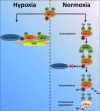The hypoxia-inflammation link and potential drug targets
- PMID: 21659868
- PMCID: PMC3259566
- DOI: 10.1097/ACO.0b013e32834873fd
The hypoxia-inflammation link and potential drug targets
Abstract
Purpose of review: Hypoxia represents one of the strongest transcriptional stimuli known to us. In most cases, hypoxia-induced changes in gene expression are directed towards adapting tissues to conditions of limited oxygen availability.
Recent findings: As a well known example, physical exercise at high altitude results in the transcriptional induction of erythropoietin that functions to increase oxygen carrying capacity and red cell volume. Studies of the transcriptional pathway responsible for the induction of erythropoietin during conditions of hypoxia led to the discovery of the transcription factor hypoxia-inducible factor (HIF) that is known today as the key transcription factor for hypoxia adaptation. Surgical patients are frequently at risk for experiencing detrimental effects of hypoxia or ischemia, for example, in the context of acute kidney injury, myocardial, intestinal or hepatic ischemia, acute lung injury, or during organ transplantation.
Summary: In the present review, we discuss the mechanisms of transcriptional adaptation to hypoxia and provide evidence supporting the hypothesis that targeting hypoxia-induced inflammation can represent novel pharmacologic strategies to improve perioperative outcomes. Currently, such strategies are being explored at an experimental level, but we hope that some of these targets can be translated into perioperative patient care within the next decade.
Figures


References
-
- Eltzschig HK, Carmeliet P. Hypoxia and inflammation. N Engl J Med. 2011;364:656–65. - PMC - PubMed
-
This comprehensive review article summerizes the molelcular mechanism of the interdependence between hypoxia and inflammation. It furthermore explains in detail how HIF is regulated and how this regulation might alter the course of disease in various pathophysioloigcal settings.
-
- Andrade CF, Kaneda H, Der S, et al. Toll-like receptor and cytokine gene expression in the early phase of human lung transplantation. J Heart Lung Transplant. 2006;25:1317–23. - PubMed
-
- De Perrot M, Sekine Y, Fischer S, et al. Interleukin-8 release during early reperfusion predicts graft function in human lung transplantation. Am J Respir Crit Care Med. 2002;165:211–5. - PubMed
Publication types
MeSH terms
Substances
Grants and funding
LinkOut - more resources
Full Text Sources
Research Materials

